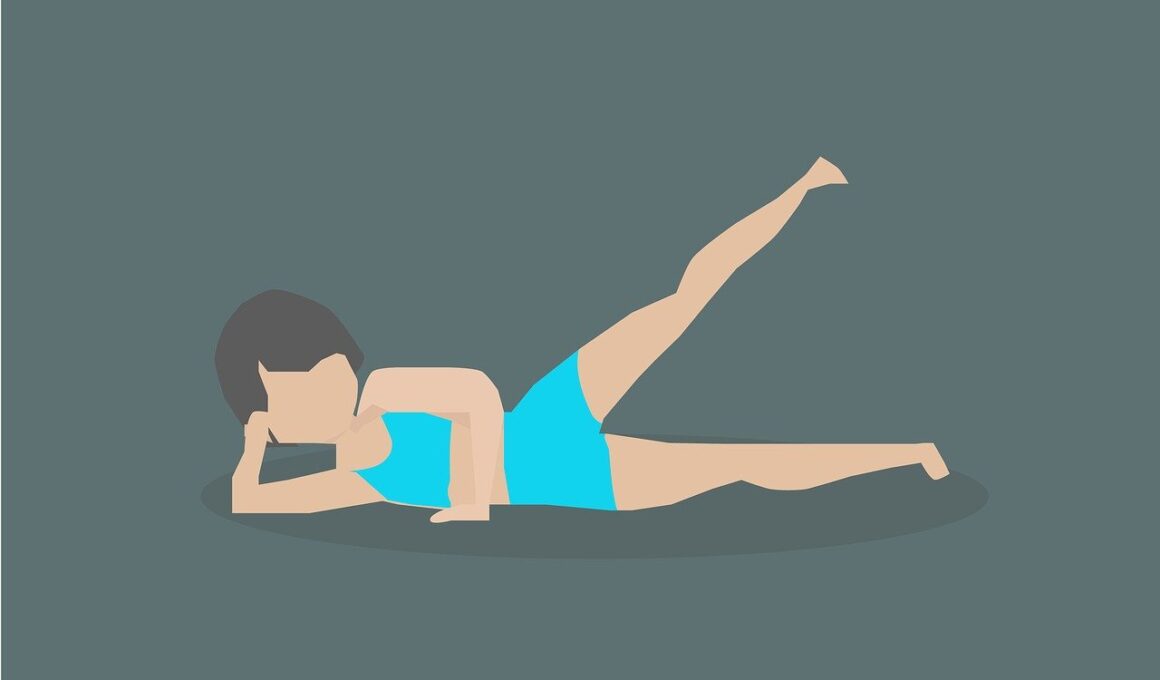Combine Leg Raises with Dynamic Movements for a Tougher Core
Leg raises are a powerful exercise for strengthening the core, primarily targeting the lower abdominal muscles. They can significantly improve overall core stability, enhancing performance in various physical activities. When combined with dynamic movements, leg raises become even more effective at challenging the core. Integrating exercises like mountain climbers, plank variations, or even burpees can help to intensify the workout. This not only increases the number of muscles engaged during the workout but also builds endurance and strength over time. Utilizing various combinations can lead to a more comprehensive core workout, engaging obliques and stabilizing muscles. To begin, find a comfortable space, ideally on a mat, and maintain proper form throughout the exercises. Breathing techniques and timing also play crucial roles in maximizing the effectiveness of your routine. Ensure that your back remains pressed into the mat to avoid unnecessary strain. As you progress, consider slowly increasing repetitions or integrating weights to further challenge your core stability. Remember to incorporate a warm-up session to prepare your body adequately and reduce injury risks.
Benefits of Combining Leg Raises with Dynamic Movements
When engaging in calisthenics, the combination of leg raises with dynamic movements revamps traditional training methods. This approach provides numerous benefits, including increased muscle engagement and enhanced functionality for everyday tasks. By refining coordination and balance, individuals can experience improved athletic performance across various sports. Furthermore, pairing these exercises fosters improved metabolic conditioning, optimizing fat-burning processes during workouts. This increased efficiency enables individuals to achieve better results in shorter workout periods. Importantly, incorporating a mix of static and dynamic movements aids in preventing workout boredom, keeping motivation levels high. This can be particularly beneficial for individuals who may feel disenchanted with traditional training routines. Engaging the core in diverse ways allows for robust development of harmony among various muscle groups. Additionally, this versatile approach can aid in increasing flexibility and mobility around the hip joints. By employing different planes of movement, individuals can unlock greater ranges of motion while minimizing the risk of injury. As a result, a strategic integration of leg raises and dynamic elements offers exhaustive benefits for anyone pursuing core strength and overall fitness.
Transitioning from static to dynamic movements can significantly enhance your workout efficiency and results. To successfully implement leg raises into dynamic routines, begin with basic leg raises ensuring proper form and technique. Gradually introduce movements like bicycle kicks or flutter kicks while maintaining the core’s engagement to maximize benefits. This can be challenging at first, but with consistent practice, the body adapts and becomes stronger. Allow yourself to master each movement before progressing to more complex alternatives. Opt for functional movements, such as hanging leg raises, which provide stability and core engagement. Suspended training forces your body to maintain its balance, further amplifying core benefits. Moreover, remember to emphasize both the concentric and eccentric phases. This focus ensures full muscle activation and promotes growth throughout the workout. Seeking guidance from fitness professionals can provide tailored advice on correct form and progression. Through structured guidance, individuals can develop a more balanced training program, ultimately leading to a stronger and more resilient core. Remember to document your progress to stay motivated and adjust your plan as necessary.
Description of Effective Leg Raise Variations
To further augment your core exercises, exploring various leg raise variations proves essential. Consider implementing different styles like hanging leg raises, incline leg raises, or lying leg raises. Each variant offers unique advantages while adding diversity to the training regimen. Hanging leg raises challenge grip strength and activate additional muscle fibers, particularly in the upper body. On the other hand, incline leg raises provide an opportunity to modify the angle, effectively targeting specific abdominal areas. Incorporating resistance bands during routine workouts can also introduce progressive resistance into leg raises, making the exercise progressively more challenging over time. Moreover, including dynamic pendulum leg raises can further enhance core stability by introducing an element of controlled movement. Rotational movements, such as windmill leg raises, engage obliques which always need attention during workouts. Always maintain proper form while performing these variations to ensure safety and effectiveness. With consistent practice, individuals can develop a strong and well-defined abdominal region. Always prioritize control and a slow tempo to reap maximum benefits from these diverse exercises while reducing injury risks. Your core will thank you for this commitment!
To incorporate these varied leg raise exercises effectively within a workout routine, organization and structure play a fundamental role. Begin by allocating time for each exercise to ensure comprehensive muscle engagement. Total training time can vary based on fitness levels, but a standard routine consists of three to four sets of each variation. Emphasizing rest time between sets allows for muscle recovery and enhances workout efficiency. Concurrently, consider integrating core stabilization exercises such as planks or stability ball work to further augment fitness levels. These complimentary movements actively challenge your core while permitting active recovery, promoting an overall stronger core. A well-balanced approach also means alternating intensity levels across training days—high-intensity workouts on alternate days allows for physical recovery without equipment dependency. Furthermore, engage in mindful movements, focusing on breathing and alignment while reducing mental distractions. Document progress by tracking sets, repetitions, or duration, which can serve as motivation for continual improvement. Encouraging camaraderie within workout classes can also lead to increased accountability, driving results. Understanding how to balance intensity with recovery is essential to ensure long-term fitness gains.
Tips for Optimal Core Development
For optimal core development through leg raises and dynamic movements, consistency becomes crucial. Allocate time throughout the week to build strength and endurance effectively. Combining multiple types of core exercises within your regimen keeps workouts fresh, promotes mental engagement, and reduces the likelihood of hitting plateaus. Additionally, never underestimate the power of nutrition in achieving core goals. Focus on a balanced diet rich in protein, healthy fats, and whole grains while staying hydrated to promote recovery and sustain energy levels. Core workouts, while challenging, should always prioritize enjoyment—find exercises that keep you engaged and committed to your routine, ensuring long-term sustainability. Emotional well-being directly influences physical performance; choose a workout partner or employ workout apps for virtual accountability to maximize motivation. Gradually increase the complexity of each exercise through progressive overload, leading to measurable strength gains. Consider incorporating active recovery days to maintain consistent attendance, enabling your body to adapt without fatigue. Techniques like yoga or stretching can provide balance while enhancing flexibility. Overall, a well-rounded approach with leg raises and dynamic movements fosters not only a stronger core but a healthier lifestyle.
As you continue to challenge your core with dynamic leg raises and complementary movements, remember to listen to your body. Overtraining can lead to fatigue and injuries, which can hinder progress and motivation. Ensure you get adequate rest days and modify workouts as necessary based on physical cues. Engage in cross-training activities that allow different muscle groups to work, providing much-needed respite for fatigued core muscles. Evaluation of your progress weekly is crucial to ensure alignment with your fitness goals. Remember to celebrate each milestone, no matter how small, as this can significantly improve your intrinsic motivation. Modify objectives when needed, adapting your training plan based on performance or how your body feels. Connecting with a community of fitness enthusiasts can also enhance activity and provide support throughout your journey while sharing best practices and experiences. Visualizing success can be remarkably beneficial; use the power of mental imagery to reinforce your commitments. As your body adapts and grows stronger, you’ll enjoy new opportunities for challenging workouts that keep your fitness journey engaging. Adapting continuously leads to further enjoyment and success in core workouts.
Conclusion
In conclusion, blending leg raises with dynamic movements creates a multifaceted approach to core workouts, leading to unmeasurable benefits for individuals committed to calisthenics. The combination fosters enhanced strength, stability, and functional fitness that translates into everyday activities. By integrating various leg raise variations and consistent training principles, long-term gains become achievable. Remember that maintaining proper form and technique is vital for reducing injuries while enhancing core muscle activation. Always experiment with new exercises and combinations that challenge not only your core but also keep the journey exciting. Ensure you remain adaptable, as flexibility within your training regimen is key to ongoing success. Acknowledge that progress comes with consistency and dedication; results will naturally follow over time. As you strengthen your core through these innovative methodologies, you’ll discover increased enjoyment in your workouts, improved athletic performance, and healthier living practices. Celebrate your achievements, and encourage others within your social circle to pursue similar fitness initiatives. This will not only foster accountability but also create a supportive environment for everyone committed to enhancing their physical well-being.


